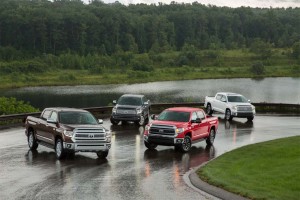
The new super-agency will handle a wide range of brands and products, including the new 2014 Toyota Tundra
“A merger of equals!” Seems there’s a certain familiarity to that corporate-speak-cliché, isn’t there? Based on the news coverage, analysis and punditry of the proposed merger between Publicis and Omnicon — already two of the world’s largest – ad agency groups — it’s going to work to the advantage of the involved corporations, its c-suite executives, their stockholders, stock option holders, platinum parachute beneficiaries and others who believe bigger is better.
But what about the agencies’ clients? Especially the automotive clients.
The individual holding companies can count among themselves is a blue chip list of big spending automotive customers. Toyota’s agency, Saatchi & Saatchi, is owned by Publicis, as is Leo Burnett which works for both Buick and GMC. Omnicom owns TBWA Chait Day, the shop that handles the Nissan account in the U.S. and internationally, while another Omnicom shop, Merkley+Partners, is the AOR – that’s agency-of-record for civilians — for Mercedes-Benz. Oh, and then there’s Volkswagen which, outside the U.S. is at the DDB shop which is also owned by Omnicom. That’s a total of five of the top ten most prestigious auto brands in the world.
In a tri-city international tour the CEOs of Publicis and Omnicon have spoken of the synergy the new company will have with combined resources – like buying power clout and advanced technological abilities — but not much has been said about client conflicts, and we all know how paranoid clients can be about secrecy and privacy. It’s not the elephant in the room, just a minor annoyance which can and must be resolved if and when the issue comes up.
What I have not read is any predictions of improved creativity which is usually the reason clients switch agencies. Internet, social media and hi-tech have changed the landscape of the advertising business significantly, but the process of creating ads remains labor intensive and ethereal and requires creative staffs to come up with original concepts combined with account service knowledge.
Experience must be combined with quantitative research. All the computer algorithms combined probably couldn’t make a compelling ad in any medium. The ad business is a rare example of disparate skills working together to gain an advantage for a client. It is a personal business not one of key strokes.
There have also been comments from the non-ad-media-world about the necessity for improving the profitability of an account on a per employee basis when compared to Google’s advertising business, the behemoth of power in ad media and marketing today. Google, with a few key strokes can put a website out of business or bring countless web surfers to the competition. It is a potential power struggle between Goliaths: the one that picks the media and the other who owns it.
Platitudes aside, the merger of equals seems to have little impact on existing clients – sure there may be a few deflections – but probably none of the five mentioned earlier. There are other automotive brands that may benefit from increased completion for their business from other non-holding company owned shops and/or independents that are going to mount impressive efforts from their new biz rainmakers based on personal and professional creativity, service, creativity and service.
Is the big merger a big deal or a bad deal? My thinking is when the big merger becomes a big oops – history does repeat itself – perhaps better advertising will result. So in the end the client is going to win no matter what happens.
